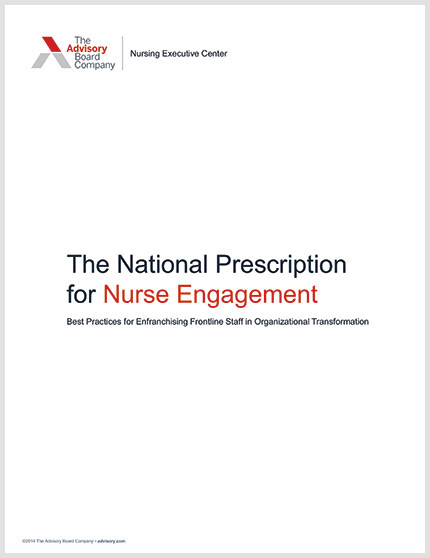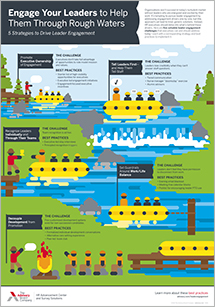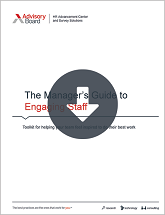Auto logout in seconds.
Continue LogoutIn 2012, the H. Lee Moffitt Cancer Center and Research Institute discovered that its workforce engagement had fallen to the 19th percentile of national engagement trends, so it set out on a mission to improve those scores—and rose to the 87th percentile in engagement nationwide, Dörte Heimbeck and colleagues write for NEJM Catalyst.
Get the manager's guide to engaging staff
Heimbeck, the director of organizational development for Moffitt; Lisa Riley, the manager for the organizational development program office at Moffitt; and Alan List, president and CEO of Moffitt, write that news of the institute's low engagement performance arrived around the time "the cancer center welcomed a new CEO, who viewed workforce engagement as a priority and as an important indicator of senior leadership performance and success."
As such, the center embarked on a five-year effort to "create an environment and a leadership culture that would sustain high levels of engagement in the face of ongoing change," Heimbeck and colleagues write.
Moffitt embraced a four-part strategy that drove the dramatic improvements:
1) Increase accountability
The authors write that their first step was to tie engagement scores to "performance evaluations and incentive plans for all members of leadership." They did so in phases: first requiring managers to participate in certain activities to qualify for incentives, and later requiring managers to achieve specific levels of engagement or percentage improvements, the authors write.
Only a small percentage of manager's overall incentives were tied to engagement scores, but even so, the strategy brought the issue to the forefront for many teams. Eventually, they write, "management accepted as a new normal that engagement would be a leadership responsibility."
2) Increase engagement survey frequency and response rates
The cancer center also decided to increase the frequency of engagement surveys, making them a regular annual occurrence as opposed to an "event" that occurred only every 18 to 24 months. The cancer center also sought to increase staff participation by:
- Implementing a survey ambassador program, with more than 100 team members championing participation;
- Creating an online resources page that included features such as an FAQ page, a live participation thermometer, and a listing of participation rates by department; and
- Updating response rates, which were broken down by senior leaders, two times per week.
3) After each survey, identify and solve a distinct problem
After receiving the annual survey results, the cancer center identifies and adopts a new organization-wide theme for improving engagement, such as "Communication" (the theme for 2015) or "Collaboration" (the theme for 2016).
The center hosts four to six "open forums" on campus that allow all team members to meet with senior leaders to discuss that year's theme. The authors write that team members "felt empowered to take charge and make improvements in their own areas, and leadership not only supported but also publicly praised these examples of engagement."
4) Share engagement results with all staff
The authors write that the organization emphasized maintaining transparency throughout its initiative, and "has made it a priority to provide all team members with access to survey data."
As part of that effort, managers are encouraged "to share work unit-specific results with their team members directly by creating simple slideshow templates into which managers can easily incorporate their own data."
Moffitt also used town hall meetings and "Did You Know" flyers to show how team member feedback specifically led to changes made within the organization.
Dramatic results
Under the new engagement strategy, Moffitt saw its engagement scores jump from the 19th percentile to the 87th percentile between 2012 and 2017.
The authors write that Moffitt has also seen steadily increasing engagement among both nurses and physicians, as well as "improved trust between leadership and team members," as well as "a greater sense of communication and collaboration in the organization" (Heimbeck et. al., NEJM Catalyst, 5/9).
Learn more: Get the manager's guide to engaging staff
Get more than 20 ready-to-use tools to improve your team’s engagement. You'll find tools to recognize staff, collect their input, support their professional development, and more.
Don't miss out on the latest Advisory Board insights
Create your free account to access 1 resource, including the latest research and webinars.
Want access without creating an account?
You have 1 free members-only resource remaining this month.
1 free members-only resources remaining
1 free members-only resources remaining
You've reached your limit of free insights
Become a member to access all of Advisory Board's resources, events, and experts
Never miss out on the latest innovative health care content tailored to you.
Benefits include:
You've reached your limit of free insights
Become a member to access all of Advisory Board's resources, events, and experts
Never miss out on the latest innovative health care content tailored to you.
Benefits include:
This content is available through your Curated Research partnership with Advisory Board. Click on ‘view this resource’ to read the full piece
Email ask@advisory.com to learn more
Click on ‘Become a Member’ to learn about the benefits of a Full-Access partnership with Advisory Board
Never miss out on the latest innovative health care content tailored to you.
Benefits Include:
This is for members only. Learn more.
Click on ‘Become a Member’ to learn about the benefits of a Full-Access partnership with Advisory Board
Never miss out on the latest innovative health care content tailored to you.



